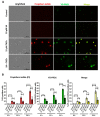Targeting 7KCh-Induced Cell Death Response Mediated by p38, P2X7 and GSDME in Retinal Pigment Epithelium Cells with Sterculic Acid
- PMID: 38004569
- PMCID: PMC10675123
- DOI: 10.3390/pharmaceutics15112590
Targeting 7KCh-Induced Cell Death Response Mediated by p38, P2X7 and GSDME in Retinal Pigment Epithelium Cells with Sterculic Acid
Abstract
Age-related macular degeneration (AMD) is the main cause of blindness in developed countries. AMD is characterized by the formation of drusen, which are lipidic deposits, between retinal pigment epithelium (RPE) and the choroid. One of the main molecules accumulated in drusen is 7-Ketocholesterol (7KCh), an oxidized-cholesterol derivative. It is known that 7KCh induces inflammatory and cytotoxic responses in different cell types and the study of its mechanism of action is interesting in order to understand the development of AMD. Sterculic acid (SA) counteracts 7KCh response in RPE cells and could represent an alternative to improve currently used AMD treatments, which are not efficient enough. In the present study, we determine that 7KCh induces a complex cell death signaling characterized by the activation of necrosis and an alternative pyroptosis mediated by P2X7, p38 and GSDME, a new mechanism not yet related to the response to 7KCh until now. On the other hand, SA treatment can successfully attenuate the activation of both necrosis and pyroptosis, highlighting its therapeutic potential for the treatment of AMD.
Keywords: 7-ketocholesterol; AMD; GSDME; P2X7; cell death; retina; sterculic acid.
Conflict of interest statement
I.M.L. holds a patent on “Methods of treatment using sterculic acid”. The funders had no role in the design of the study; in the collection, analyses, or interpretation of data; in the writing of the manuscript, or in the decision to publish the results.
Figures










Similar articles
-
Identification of 7-Ketocholesterol-Modulated Pathways and Sterculic Acid Protective Effect in Retinal Pigmented Epithelium Cells by Using Genome-Wide Transcriptomic Analysis.Int J Mol Sci. 2023 Apr 18;24(8):7459. doi: 10.3390/ijms24087459. Int J Mol Sci. 2023. PMID: 37108627 Free PMC article.
-
7-Ketocholesterol disturbs RPE cells phagocytosis of the outer segment of photoreceptor and induces inflammation through ERK signaling pathway.Exp Eye Res. 2019 Dec;189:107849. doi: 10.1016/j.exer.2019.107849. Epub 2019 Oct 23. Exp Eye Res. 2019. PMID: 31655042
-
Cholesterol oxidation in the retina: implications of 7KCh formation in chronic inflammation and age-related macular degeneration.J Lipid Res. 2010 Oct;51(10):2847-62. doi: 10.1194/jlr.R004820. Epub 2010 Jun 21. J Lipid Res. 2010. PMID: 20567027 Free PMC article. Review.
-
Inflammatory and cell death mechanisms induced by 7-ketocholesterol in the retina. Implications for age-related macular degeneration.Exp Eye Res. 2019 Oct;187:107746. doi: 10.1016/j.exer.2019.107746. Epub 2019 Aug 5. Exp Eye Res. 2019. PMID: 31394101 Review.
-
7-ketocholesterol accumulates in ocular tissues as a consequence of aging and is present in high levels in drusen.Exp Eye Res. 2014 Nov;128:151-5. doi: 10.1016/j.exer.2014.09.009. Epub 2014 Sep 26. Exp Eye Res. 2014. PMID: 25261634 Free PMC article.
Cited by
-
Role of P2X7R in Retinal Diseases: A Review.Immun Inflamm Dis. 2025 May;13(5):e70203. doi: 10.1002/iid3.70203. Immun Inflamm Dis. 2025. PMID: 40396593 Free PMC article. Review.
References
Grants and funding
LinkOut - more resources
Full Text Sources

